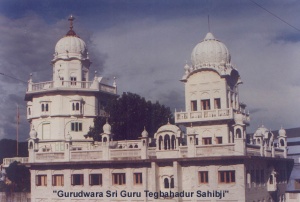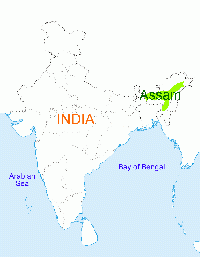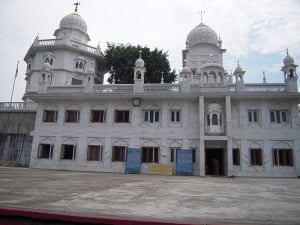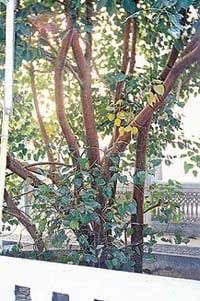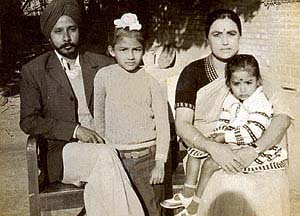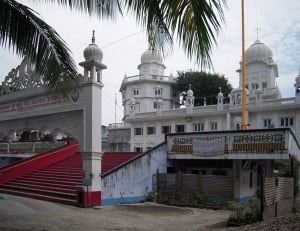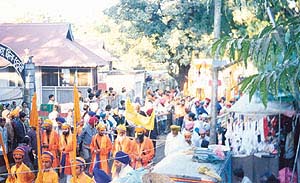Gurdwara Sri Guru Tegh Bahadur Sahib (Dhubri)
Gurdwara Sri Guru Tegh Bahadur Sahib - This famous Gurudwara is situated in the heart of the Dhubri Town on the bank of the mighty Brahmaputra river in far north-east India in the state of Assam. Guru Nanak the first Sikh Guru visited this place in 1505 and met Srimanta Sankardeva (the founder of the Mahapuruxiya Dharma) as the Guru travelled from Dhaka to Assam.
This historic shrine, Sri Gurdwara Guru Tegh Bahadur or Damdama Sahib at Dhubri in Assam was built in memory of the visit of Guru Nanak. Hence it has great importance for Sikh community. Guru Tegh Bahadur established this Gurdwara during his 17th century visit to the area. Sikh devotees from all over India and the world assemble in this Gurdwara every year in the month of December to mark the martyrdom of Guru Tegh Bahadur with due solemnity and ceremony. Sikh devotees call this festival Sahidee Guru Parav.
It was during his stay in Dhubri, that the ninth Guru received the news that a son was born to him at Patna. This son was Gobind Rai who later became the highly respected tenth Guru, Sri Guru Gobind Singh. He succeeded to the Guru Gaddi after the execution of his father in Chandni Chowk, Delhi by the order of the Mughal Emperor Aurangzeb in 1675.
History
When Raja Ram Singh son of Mirza Raja Jai Singh was deputed by Emperor Aurangzeb to crush the revolt of King Chakradhwaj Singh of Kamrup (Assam), he called on Guru Tegh Bahadur at Dhaka and requested that he accompany him on his expedition to Assam. His request was accepted by the Guru who had planned to visit Assam in order to revive the religious centre built to commemorate the visit of Guru Nanak in the land of magic and beauty. Together Raja Ram Singh and Guruji, marched along the river Dhubri and Brahmaputra and reached Kamrup early in February, 1669 A.D. Guru Tegh Bahadur camped at Dhubri while Raja Ram Singh camped at Rangamati. The Imperial Army was confident of its strength but was not as yet sure whether the holyman with them would be able to destroy the evil effects of magic and witchcraft of the Assamese. Just across the river the Assamese were unnerved by the superior numbers of the Imperial Army but they were confident that the supernatural powers of their magicians backed by their tactful resistance would keep the attackers at bay.
The magic Assamese women with their tantric paraphernalia began reciting mantras of destruction in their encampment directly across the river of the camp of Guru Tegh Bahadur. But all their magic failed to harm the great Guru. The magicians were too confident about their ability to destroy any human being. From across the river they hurled a 26 feet long stone, which came arcing across the sky like a missile and struck the ground, near Guruji's camp, so hard that nearly half of its length was embedded in the ground. It can still be seen in the same position.
Their magic comes to an end
When their missile of stone failed to harm the holy benefactor, the magician next flung a tree, which fell very close to the Guru's camp without causing injury to any one. Then, as Guru Tegh Bahadur took his bow and aimed an arrow at the altar of magic all of their magic and sorcery came to a sudden end. The magicians realised that superior powers had completely deprived them of their magical strengths and stilled their willpower, so they crossed the river to the Guru's camp and begged forgiveness for having offended him. They told him that they were fighting only to repell the foreigners who had come to enslave them.
Guru Tegh Bahadur assured the magicians that he would work to bring peace between Raja Ram Singh and the Ahom King, for which, a change of heart was necessary on both sides. Consequently, he advised Raja Ram Singh to achieve his rulers objectives through peaceful negotiations and not to fight unless he was attacked. The rest of the story is a part of the history as to how he succeeded in patching up the differences between the Imperial Commander Raja Ram Singh and the Ahom King of Assam. The grateful Ahom King invited Guruji to the Kamakhya shrine, where he was honoured with great respect.
The Peace Mound of Dhubri
The happy occasion of the peace settlement brought about by the efforts of Guru Tegh Bahadur was celebrated by a joint homage to the shrine of Guru Nanak by both the Mughal and the Ahom armies. The mound of peace of Dhubri was erected with the red earth carried by the soldiers of both the armies on their shields. This permanent monument to Guru Tegh Bahadur's a successful peace efforts stands at Dhubri to this day. Pilgrims from all over India visit Dhubri to pay homage at Gurdwara Damdama Sahib. They also visit the mound of peace constructed by Hindus an& Muslims soldiers of the two armies.
The Janamsakhis are unanimous about Guru Nanak Dev's visit to Kamrup (Assam) but no sangat or historical shrine dedicated to him survives.
Guru Tegh Bahadur visited Assam in 1670. He had accompanied Raja Ram Singh of Amber who had been sent by Aurangzeb to quell a rebellion by the Ahom chief Chakradhwaj. Assam was a difficult country to operate in and for Raja Ram Singh it was a task assigned to him as a punishment because it was from his custody that Shivaji and his son had escaped, from Aurangzeb's likely execution, a few years earlier. Guru Tegh Bahadur's presence, therefore, was a moral booster to both him and his troops. The Guru's role, however, proved to be much more essentual to the results than his mere presence. Pacifist that the famed Guru was, his efforts were essential in the peace agreement concluded between the former enemies.
The place of reverence
As a monument to peace, a high mound was raised to which every soldier contributed five shieldfuls of earth. This mound standing on the right bank of the Brahmpra River at Dhubri, a sub-divisional town in Goalpara district of Assam, came to be treated as a sacred shrine. A Gurdwara was also built near it on the spot where Guru Tegh Bahadur had stayed and negotiated peace. It was looked after by Udasi priests until it was destroyed in an earthquake around 1896-97. Bhai Ram Singh, an official of the shrine, reconstructed a room in 1901. The Mahants, originally, possessed a farman (fiat) of a Mughal emperor pertaining to a land grant to the shrine. In 1902-03, Mahant Jai Singh took this Farman with him when he went to Punjab to raise funds through donations for the Gurdwara building under reconstruction. Unfortunately Bhai Jai Singh died on this trip somewhere near Amritsar, and the Farman was lost.
There are currently two Gurdwaras located here:
- Gurdwara Thara Sahib or Damdama Sahib - In 1966, a Gurdwara in a small octagonal hut with sloping roof was also set up on top of the mound. It is called Thara Sahib or Damdama Sahib.
- Gurdwara Sri Guru Tegh Bahadur - The other shrine called Gurdwara Sri Guru Tegh Bahadur is in a square hall with wooden walls and sloping roof. Further development of the Gurdwara is afoot under the Sikh Pratinidhi Board Eastern Zone and the local managing committee.
To reach Dhubri the rail route, via Katihar and Siliguri, is convenient. One has to change trains (or direction) at Fakiragram junction for Dhubri, a distance of about 70 kilometres by rail or road.
Sikhs of Assam
Sikhs who enjoy doing bihu, not bhangra by Parbina Rashid for The Tribune April 19, 2003
Who says one has to know Punjabi or bhangra to be called a Sikh? Here is this community in Assam which enjoys doing Bihu dance (folk dance from Assam), has no knowledge of Punjabi language or culture yet follows Sikh teachings with a rigidity which is no way less than the Sikhs in Punjab. Displaced from their place of origin centuries ago, this community of Assamese Sikhs living in a remote area of Nowgoan district are often dubbed and ridiculed by their counterparts here as 'second-class Sikhs'.
A whopping number of about 10,000 Assamese Sikhs are mainly concentrated in Nowgaon district. Their turbans may not go well with their Mongoloid features and sparse beards, and may even fetch them belittling remarks from other Sikhs yet they remain a proud race. "Our forefathers came to Assam centuries ago to rescue the Assamese people from foreign invasion and that makes us feel proud. As far as our religion is concerned, we have been following it with utmost devotion," says one of the Assamese Sikhs, voicing the general sentiment of his community.
And these Sikhs don’t feel nostalgic about being away from Punjab, its culture and its people. "We are Assamese who are following the Sikh religion. We have adopted this place as our own, as we have been living here for generations."
Don't left appearance deceive you
So let not appearances throw you off gear as you enter the house of one of these families. You are not likely to be greeted with a glass of water or soft drink but with a sarai containing betel nut and paan — the traditional offering made by the Assamese. Even the lady of the house looks like just any other Assamese married women — adorned with sindoor and clad in mekhla – chaddar, the traditional Assamese dress — till your eyes rest on the tiny kirpan tucked under the chaddar.
Then come the male folk and you heave a sigh of relief — some similarities at last — the turban and the beard (though sparse) is there. But even with them you will not be able to strike a conversation in Punjabi. And what is more, their names also have an Assamese accent to it.
As you take a peep into their customs, you realise that they have not only assimilated themselves into the Assamese society to a large extent but have also remained loyal to their religion. They celebrate both Magh Bihu and Lohri, which fall on the same day — January 13. With equal enthusiasm they celebrate both Gurpurb and Shankar Dev's tithi as well as participate in Bohag Bihu and Durga Puja, the two most widely celebrated festivals of Assam.
"We have never felt that we are not a part of the Assamese society and at the same time we have been faithful to our religion," says S. K. Singh, president of the Assam Sikh Association. "But it hurts us when we are called ‘duplicate Sikhs’ or ‘second class Sikhs’ by our counterparts in Punjab," he adds.
"In fact in some respects, we are more staunch than the Punjabi Sikhs," says Jaswant Kaur. "We may not speak the language but we follow our religious book very seriously. Most of us are amritdharis, as it is our custom to partake of amrit before we get married," she adds. And they are proud of their heritage too. Visit any of the families in Borkola and you are likely to hear this line over and over again: "when Giani Zail Singh visited Borkola in 1975, he was surprised at the way we are following the Guru Granth Sahib."
Assam's link to Sikhs
The settlement of this community in Assam can be traced back to the third Burmese attack when King Viswanarayan Singh of the Ahom tribe sought Maharaja Ranjit Singh's help to defeat the Burmese army. It was around that time when 500 soldiers were sent under the leadership of Chetan Singh. They crossed the Brahmaputra and Kalang rivers and reached Chaparmukh. After defeating the Burmese, most of them settled there. General Chetan Singh died in the war but his wife who is known as 'Mataji' survived. Most of the Sikhs of Assam are descendents of Mataji and considered as upper class Sikhs for their pure lineage. There is yet another branch of Assamese Sikhs which is not so pure in its lineage. One Ram Singh who went to Assam in the year 1823 got married to an Assamese girl and settled in Borkola.
Mataji Gurdwara in Borkola village is the most popular Sikh shrine in this region. The site where a gurdwara now stands in Dhubri district was visited by Guru Teg Bahadur. The local Sikhs are full of the miracles he performed during his stay there. However the ultimate pilgrimage for them still is the Golden Temple in Amritsar.
By and large an agrarian society, the new generation of Assamese Sikhs has come out of its shell to take up responsible positions in government and private sector. They are now teachers, businessmen, and officers in the civil services. Though now they have begun picking up jobs in other parts of the state, they are still plagued by feelings of insecurity. And this is the reason behind the formation of the Assam Sikh Association.
"We are the smallest minority community in the region but we have not been granted minority status so far," says S. K. Singh. " The association is going to demand minority status and along with that representation in local bodies and state assembly," he adds.
Till they get this status, Assamese Sikhs have a tough fight ahead to assimilate into the local society and also to prove to the Punjabi Sikhs that they too are respectable Sikhs.
- the above article thanks to: tribuneindia.com
